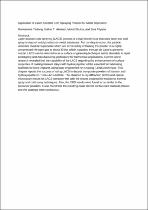JavaScript is disabled for your browser. Some features of this site may not work without it.
- ResearchSpace
- →
- Research Publications/Outputs
- →
- Book Chapters
- →
- View Item
| dc.contributor.author |
Tlotleng, Monnamme

|
|
| dc.contributor.author |
Akinlabi, ET

|
|
| dc.contributor.author |
Shukla, M

|
|
| dc.contributor.author |
Pityana, Sisa L

|
|
| dc.date.accessioned | 2016-07-22T07:44:12Z | |
| dc.date.available | 2016-07-22T07:44:12Z | |
| dc.date.issued | 2014-02 | |
| dc.identifier.citation | Tlotleng, M, Akinlabi, ET, Shukla, M and Pityana, S. 2014. Application of laser assisted cold spraying process for metal deposition. In: Surface Engineering Techniques and Applications: Research Advancements. Pennsylvania, USA: IGI Global, pp 177-221 | en_US |
| dc.identifier.uri | http://www.igi-global.com/chapter/application-of-laser-assisted-cold-spraying-process-for-materials-deposition/105461 | |
| dc.identifier.uri | http://hdl.handle.net/10204/8682 | |
| dc.description | Copyright: Pennsylvania,USA: IGI Global. Due to copyright restrictions, the attached PDF file only contains the abstract of the full text item. For access to the full text item, please consult the publisher's website | en_US |
| dc.description.abstract | Laser assisted cold spraying (LACS) process is a hybrid technique that uses laser and cold spray to deposit solid powders on metal substrates. For bonding to occur, the particle velocities must be supersonic which are achieved by entraining the powder in a highly compressed Nitrogen gas at about 30 bar which is passed through de Laval supersonic nozzle. LACS can be referred to as a surface engineering technique and is desirable in rapid prototyping and manufacturing; particularly for biomedical applications. Current world research revealed that the capability of the LACS regarding the enhancement of surface properties of coating titanium alloys with hydroxyapatite will be essential for fabricating scaffolds for bone implants using laser engineered net shaping (LENS) technique. This chapter reports the success of using LACS to deposit composite powders of titanium and hydroxyapatite on Ti-6Al-4V substrate. The obtained X-ray diffraction (XRD) and optical microscopy results for LACS compare well with the results obtained for traditional thermal spray and cold spray techniques. Also, the XRD results were found to be similar to the precursor powders. It was found that the resulting coats did not contain new material phases and the coatings were continuous. | en_US |
| dc.language.iso | en | en_US |
| dc.publisher | IGI Global | en_US |
| dc.relation.ispartofseries | Worklist;14337 | |
| dc.subject | Laser assisted cold spraying | en_US |
| dc.subject | LACS | en_US |
| dc.subject | Surface engineering technique | en_US |
| dc.title | Application of laser assisted cold spraying process for metal deposition | en_US |
| dc.type | Book Chapter | en_US |
| dc.identifier.apacitation | Tlotleng, M., Akinlabi, E., Shukla, M., & Pityana, S. L. (2014). Application of laser assisted cold spraying process for metal deposition., <i>Worklist;14337</i> IGI Global. http://hdl.handle.net/10204/8682 | en_ZA |
| dc.identifier.chicagocitation | Tlotleng, Monnamme, ET Akinlabi, M Shukla, and Sisa L Pityana. "Application of laser assisted cold spraying process for metal deposition" In <i>WORKLIST;14337</i>, n.p.: IGI Global. 2014. http://hdl.handle.net/10204/8682. | en_ZA |
| dc.identifier.vancouvercitation | Tlotleng M, Akinlabi E, Shukla M, Pityana SL. Application of laser assisted cold spraying process for metal deposition.. Worklist;14337. [place unknown]: IGI Global; 2014. [cited yyyy month dd]. http://hdl.handle.net/10204/8682. | en_ZA |
| dc.identifier.ris | TY - Book Chapter AU - Tlotleng, Monnamme AU - Akinlabi, ET AU - Shukla, M AU - Pityana, Sisa L AB - Laser assisted cold spraying (LACS) process is a hybrid technique that uses laser and cold spray to deposit solid powders on metal substrates. For bonding to occur, the particle velocities must be supersonic which are achieved by entraining the powder in a highly compressed Nitrogen gas at about 30 bar which is passed through de Laval supersonic nozzle. LACS can be referred to as a surface engineering technique and is desirable in rapid prototyping and manufacturing; particularly for biomedical applications. Current world research revealed that the capability of the LACS regarding the enhancement of surface properties of coating titanium alloys with hydroxyapatite will be essential for fabricating scaffolds for bone implants using laser engineered net shaping (LENS) technique. This chapter reports the success of using LACS to deposit composite powders of titanium and hydroxyapatite on Ti-6Al-4V substrate. The obtained X-ray diffraction (XRD) and optical microscopy results for LACS compare well with the results obtained for traditional thermal spray and cold spray techniques. Also, the XRD results were found to be similar to the precursor powders. It was found that the resulting coats did not contain new material phases and the coatings were continuous. DA - 2014-02 DB - ResearchSpace DP - CSIR KW - Laser assisted cold spraying KW - LACS KW - Surface engineering technique LK - https://researchspace.csir.co.za PY - 2014 T1 - Application of laser assisted cold spraying process for metal deposition TI - Application of laser assisted cold spraying process for metal deposition UR - http://hdl.handle.net/10204/8682 ER - | en_ZA |






